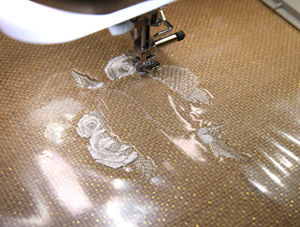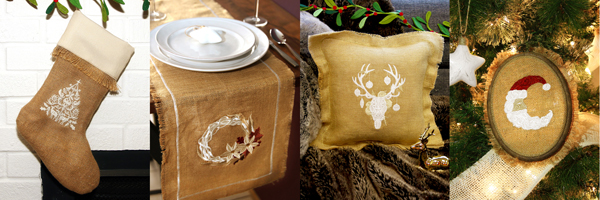If you’re looking for that rustic look for a project, look no further than the rough charm of burlap! While it may seem an unconventional fabric for embroidery, all you need are a few tips and tricks to get your best results on this old-world style fabric.
Designs Used

The first thing you’ll want to consider is the type of burlap you’re stitching on. Burlap is available in many fabric stores -- we found ours near the “utility fabrics” such as Insul-Bright, interfacing, and plain canvas. It can also sometimes be found in craft stores back by the embroidery supplies.
The big thing here is the weave. Too coarse and open, like the burlap on the right, won’t embroider well. Basically, if you can see through it, you shouldn’t stitch on it.

The next most important thing to consider is your design type. Solid, stitch-filled designs will work best with burlap. Avoid scribble or running-stitch designs, and designs with thin areas of stitching, as these will easily sink or “disappear” into burlap’s rough weave.

Finally, your secret weapons will be two different kinds of stabilizer.
Use a medium weight cutaway stabilizer that’s smoothed to the back of your burlap fabric with temporary spray adhesive. This is absolutely necessary because of burlap’s extremely coarse, loose weave. A water-soluble topping such as Sulky Solvy will help keep the stitches from “sinking in” to the fabric and becoming less neat and visible.

So, put it all together and tightly hoop the whole sandwich.

Now load up your design, and get your hoop set up under your machine!

You can see as your design starts to stitch, the water soluble topping keeps the stitches floating on top, instead of sinking into the coarse weave.

When your design is done stitching, remove the hoop.
Next, carefully tear away as much of the water soluble stabilizer topping as possible. Large chunks should come off pretty easily, but you might need a tweezers or other small sharp item to pull out stabilizer from the tinier areas. The more stabilizer you tear away, the better it will look after you soak it.

Before you soak your burlap to remove the last of the water-soluble stabilizer, trim away the excess cutaway stabilizer from the back of the design.

Finally, soak the fabric to remove any leftover stabilizer by following your stabilizer package directions.
TIP! We found that soaking can add a slight dark stain effect to burlap. So to avoid a “dark spot” on your project, we recommend soaking the whole piece of burlap, not just the area with the design. This will ensure your whole fabric comes out the same uniform tone.
Once your whole burlap piece is dry, it’s ready to be turned into a cool project!

There are all kinds of fun projects you can make with burlap. We think its rustic charm it particularly well-suited to holiday projects, but it’s a perfect year-round material. Now that you know the tricks, you can always get perfectly stitched, clean results on burlap!


